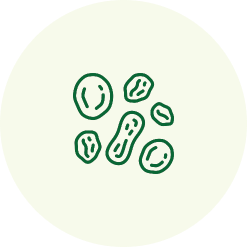MACADAMIA
Macadamia Nuts grow on evergreen trees with dark, glossy green leaves. The trees can reach 30 to 40 feet tall (9 to 12 metres), and be nearly as wide. They can be grown from seed, but because they will take 8 to 12 years to bear nuts this way, they are most often propagated by grafting, so that they will bear nuts reliably in 2 to 8 years. The roots of the tree spread out below the surface, rather than producing a large tap root like other trees. An average grafted tree will produce up to 50 pounds of nuts (22.5 kg) a year by the time it is 10 years old.
There are about 9 different species of Macadamia trees. Only two of these, “Macadamia Integrifolia” and “Macadamia Tetraphylla”, produce nuts that are edible. The other 7 just produce nuts that are too small and that taste very bitter.
The nut of the “Macadamia Integrifolia” has a smooth shell, and is up to 80% oil. The “Macadamia Tetraphylla” nut has a rough shell and a bit of a lower fat content (65 to 75%.) There are now over 40 different cultivars that have been bred from these two species.
The nuts grow with a very hard shell surrounded by a dark green husk. Inside the marble-sized nut is white. They are usually harvested by waiting for the nuts to fall to the ground, because shaking the tree can bring down nuts that aren’t ripe yet.
When eaten fresh off the tree, the texture of Macadamia Nut is creamy, almost like the inside of a fresh coconut. They must be dried for storage and shipping, however. Even when dried, they still end up with a rich, buttery flavour.
Various Types of Macadamia
Style 0 – Super Premium Whole Kernels
Super premium wholes are the king of macadamias. They are sometimes called ‘super mac’ because of the exceptionally large kernels, which range from 20mm upwards. This style comprises no less than 95% large whole (+20mm) kernel, carefully screened to ensure consistency of colour, texture and size
Style 1 – Premium Whole Kernels
Premium wholes are the most popular macadamia shape and size, because of their versatility and value for money. Premium wholes consist of a minimum 95% whole kernel with a size range from 17mm to 20mm.
Style 2 – Premium Wholes & Halves
Premium wholes and halves is a 50/50 mixture of whole kernel and large halves ranging in size from 13mm upwards. This range is one of the most versatile styles, with a variety of commercial applications. The blend of wholes & halves can be tailored to your specific requirements.
Style 3 – Premium Cocktail Mix
Premium cocktail mix is a style that fits between the table nuts and those used only as ingredients. Almost all half kernels or larger, with an average size larger than 13mm.
Style 4L – Premium Large Halves
Premium large halves and pieces are the perfect sizing for retail snack packs. This size is most commonly used for creating the ‘flavoured’ snacks such as chilli & wasabi etc, screening not less than 13mm, with 85% half kernels
Style 4S – Premium Small Halves
Premium large chips and pieces vary in size between 9mm and 11mm and deliver the perfect crunch in breakfast cereals, ice confection and cookies.
Style 6 – Premium Chips
Premium chips in sizes 4mm to 9mm. These chips are destined to be used by bakers, confectioners and chefs as ingredients, toppings or coatings in food preparation.
Style 7 – Premium Small Chips
Premium small chips in sizes 4mm to 6mm. These chips can be used in the food service industry in a similar way to Style 6, or as a specialty bread and pastry ingredient.
Style 8 – Premium Fine Chips
Premium fine chips are often selected by fine food establishments for use in sauces biscuits and desserts. 98% pass through a 4mm screen, producing 3mm to 5mm sizing.

Style 0 – Super Premium Whole Kernels

Style 1 – Premium Whole Kernels

Style 2 – Premium Wholes & Halves

Style 3 – Premium Cocktail Mix

Style 4 – Premium Halves

Style 5 – Premium Large Chips

Style 6 – Premium Chips

Style 7 – Premium Small Chips

Style 8 – Premium Fine Chips
Common Packing For Container Shipment
| Products | Packing | Container |
|---|---|---|
| Macadamia without Shell | 10 kg (22.04 lbs) vacuum bags in cartons | 430 Cartons in 20'FCL 1,763 Cartons in 40'FCL |
| 11.34 kg (25 lbs) vacuum bags in cartons | 430 Cartons in 20'FCL 1,763 Cartons in 40'FCL |
Common Packing For Container Shipment
Benefits of Macadamia Nuts
Good for the heart The healthy fats in macadamia nuts help keep the arteries in good heart-health condition
Fight disease The flavonoids in macadamias prevent cell damage and convert to antioxidants, which scavenge free radicals and fight disease.
AID in weight loss Palmitoleic acid in the macadamia has the ability to increase fat metabolism which, in turn, reduces fat storage.
Supports the Gut The macadamia helps you feel full while removing toxins from the body and assisting in good digestion.
Strengthens BonesMacadamia nuts are plentiful in phosphorus, manganese and magnesium, which aid in bone and teeth mineralization and the transportation and absorption of nutrients.
Keep the brain and nervous system on point The oleic acid in macadamias aids brain health while the palmitoleic acid helps protect nerve cells in the brain.
Reduces chronic inflammation & Arthritis symptoms Macadamia nuts low toxicity and inhibitory effect in inflammation has shown potential to reduce arthritis symptoms and prevent the onset of arthritis.
Nutrition Facts
- Serving Size: 100gm
- Amounts per servings
- Calories 715Calories from Fat 692
- % Daily Values*
- Total Fat 76g116%
- Saturated fat 12g60%
- Polyunsaturated fat 1.5g
- Monounsaturated fat 59g
- Cholesterol 0mg0%
- Sodium 5mg0%
- Potassium 368mg10%
- Total Carbohydrate 14g4%
- Dietary fiber 9g36%
- Sugar 4.6g
- Protein 8g16%
- Vitamin A0%Vitamin C2%
- Calcium8%Iron20%
- Vitamin D0%Vitamin B615%
- Vitamin B120%Magnesium32%
- *Percent Daily Values are based on a 2,000 Calorie diet.
Facts on Macadamia Nuts
Macadamia is a genus of four species of trees indigenous to Australia and constituting part of the plant family Proteaceae.They are native to north eastern New South Wales and central and south eastern Queensland. The tree is commercially important for its fruit, the macadamia nuts or simply “macadamia”). Other names include Queensland nut, bush nut, maroochi nut, bauple nut, and Hawaii nut. In Australian Aboriginal languages, the fruit is known by names such as bauple, gyndl, jindilli, and boombera. Previously, more species with disjunct distributions were named as members of this genus Macadamia.Genetics and morphological studies more recently published in 2008 show they have separated from the genus Macadamia, correlating less closely than thought from earlier morphological studies. The species previously named in the Macadamia genus may still be referred to overall by the descriptive, non-scientific name of macadamia; their disjunct distributions and current scientific names are:
- New Caledonia endemic genus Virotia in 1975 having only the type species, then by 2008 all six endemic species
- North eastern Queensland, Australian endemic genus and species Catalepidia heyana in 1995
- North eastern Queensland and Cape York Peninsula, Australia, three endemic species of Lasjia in 2008; in Australia still informally described as northern macadamias
- Sulawesi (Indonesia) two endemic species of Lasjia in 2008, based on the 1952 name M. hildebrandii and the 1995 name M. erecta










